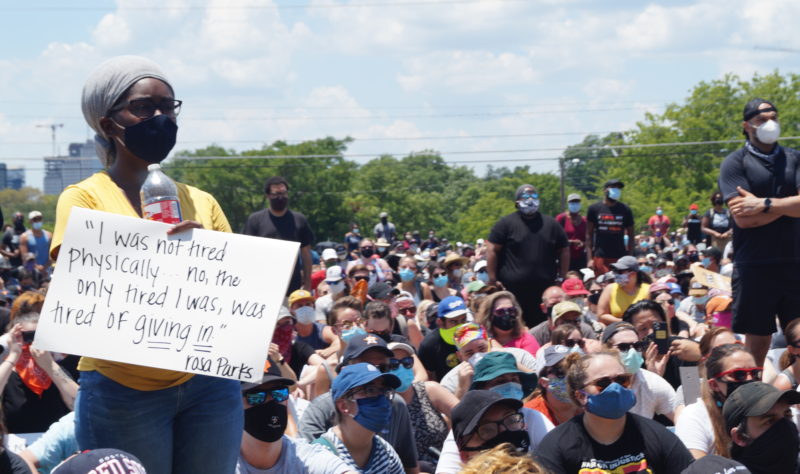“There are those who are asking the devotees of civil rights, ‘When will you be satisfied?’”
The Reverend Martin Luther King Jr. posed this question to an audience of a quarter million people at the Lincoln Memorial in 1963. Fifty-seven years later, many Americans — particularly White Americans — are wondering the same thing about Black Lives Matter and the protests engulfing the nation: ‘When will you be satisfied?’ Or in other words: What’s the endgame?
King’s answer: “We can never be satisfied as long as the Negro is the victim of the unspeakable horrors of police brutality.”
Thousands of ‘unsatisfied’ Black Americans gathered Sunday at Huston-Tillotson University, the Texas capital’s oldest and only historically Black college. Organizers cast the event not just as a protest against police brutality but also as a community gathering, at which White Austinites were welcome but not fully participant. “Today we are here together, unapologetically and proud, Black Austin,” said University President Colette Burnette.
The crowd chanted, sang, and listened to speeches. “Many of us have come here this afternoon with heavy hearts, weary minds and restless souls,” said Burnette. “The recent tumultuous turn of events have unearthed the anger, the fear, the frustration that we as Black people carry around inside of us every single day of our lives.”
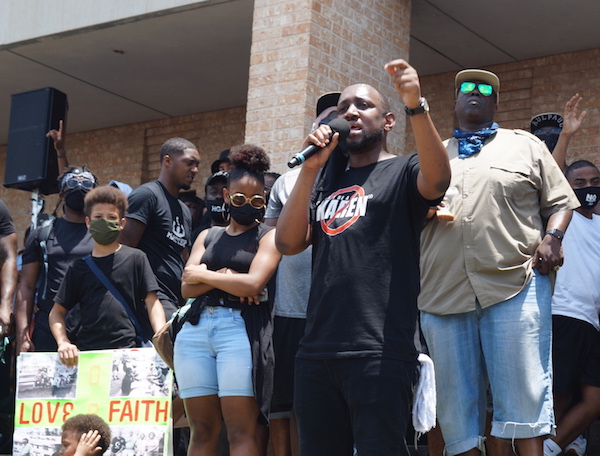
I was there to take notes, photos, record speeches, and interview rally-goers. People were relaxed, and organizers were hospitable, handing out waters, snacks, face masks, and hand sanitizer. But under the midday Texas sun, with temperatures approaching 100 degrees, speakers asked the audience to lean into the discomfort of the moment. “We have to be willing to struggle together. That’s why I asked my White brothers to go sit in the heat for a little bit,” said Chas Moore, leader of the Austin Justice Coalition, a nonprofit that organized the event.
Our masks, mandatory on the university campus, began to feel uncomfortably suffocating. EMS were on hand for heat stroke victims. I was reminded of a line from King’s famous speech: “… sweltering with the heat of injustice, sweltering with the heat of oppression…”
Civil rights in America have come a long way from 1963, but the smartphone era, which put a camera in the hand of almost every American, has unearthed evidence that police abuses are still all too common. A thread of anger ran through the speeches Sunday, deep hurt and frustration — but not the same exultant, anarchist rage that I witnessed a week earlier while reporting on looting in downtown Austin. “Be a protester, don’t be a looter… don’t be a pawn,” said Burnette, the university president. “Don’t be colonized.”
“We can love our country while simultaneously expressing our anger and protesting a constant injustice against us all.”
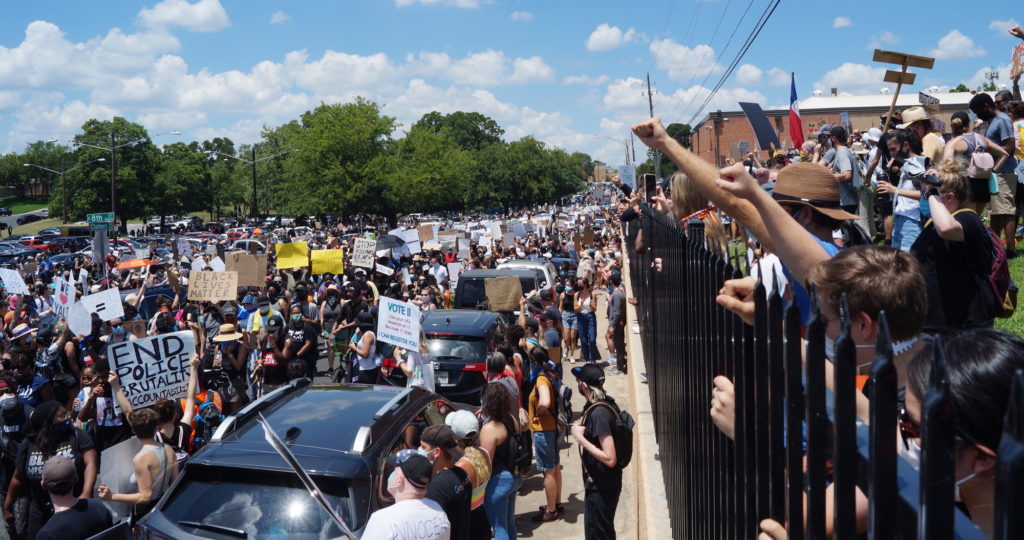
After about two hours of speeches, protesters filed out from Huston-Tillotson and marched a mile and a half to the Texas Capitol, crossing Interstate 35, the historic dividing line between Black and White Austin. In interviews, several protesters said that they were hopeful that the Black Lives Matter movement would bring changes. The response to the killing of George Floyd, they said, was far larger than earlier episodes of protest over police violence, with broad social support.
A young Black man at the demonstrations, Jacob Grant, told me that he didn’t think police brutality ever could be totally eliminated — that the ‘satisfaction’ that King had spoken of, in effect, was out of reach. But he said he was still hopeful: “I’m very optimistic that this is going to finally make things change. In my opinion we can never totally get rid of police brutality. In what profession are there not bad people at that profession?”
Grant continued, “But I believe that our voices will reach those who are higher in power who maybe will decide to make changes in our police departments, in our government, and hopefully bring it to a much lower number of policemen who abuse their power.”
This young man’s outlook surprised me because it ran counter to the utopian rhetoric of some protest leaders, including Chas Moore of the Austin Justice Coalition, who has asked audiences to “imagine a world without police,” and who lobbies at City Hall to achieve that end.
Even before the killing of George Floyd, the Austin Justice Coalition was part of a broader ‘de-policing’ movement that seeks to reduce or eliminate police departments. For proponents of this view, the police do more harm than good for Black communities, and security can better be achieved by investing in social services and mental health services.
“In the City of Austin why do we put $400 million in the police department and then come out and say we care about Black lives?” Moore said Sunday. “We can’t fix a police department that was designed to catch runaway slaves.”
This view, of course, glosses over questions of how the worst crimes, like murder, rape, or abduction, would be prevented and punished in a society without law enforcement. And though Moore is right that race and slavery have played a role in the historical development of modern law enforcement, in the English/American legal tradition law enforcement institutions actually predate the Atlantic slave trade, when England was still racially homogenous.
Still, the appeal of de-policing is that it presents a black-and-white solution to a complex and intractable problem. No police means no police violence. Simple as that. The idea also dovetails nicely with a broader Progressive agenda of boosting spending on social programs. “I think that funds need to be reallocated away from APD and towards housing and medical care,” said Kristina Reines, a White protester at Huston-Tillotson.
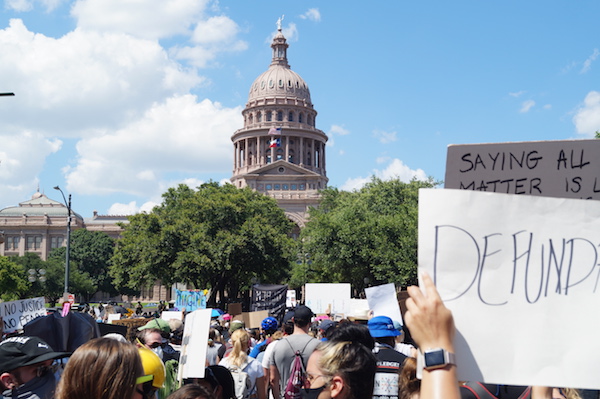
Many protesters carried signs saying “Defund APD,” or condemning APD as criminals or killers. But a few protesters walked a middle ground on the question of police funding. Emma Preston, a White protester who came with friends and family, said, “If we are going to give funds to the police” then they should be used for deescalation training, mental health training, and less violent tactics. “I think when we look at where the money is going to the police, is it going for training on mental health, is it going to training on intervening with people who maybe are in an acute crisis? What are other options than just engaging in a violent or intense way?”
During many hours of demonstrations, I didn’t see anybody calling for violence against the police, as some protesters have done at earlier rallies. The only exception was a small group of all White, black-clad protesters whom we encountered on the march between Huston-Tillotson and the Texas Capitol, who chanted about meeting “violence with violence.” Militant groups like this, which use violent protest tactics and identify broadly with the leftist protest movement known as Antifa, organized protests in Austin on May 30 and June 6, but weren’t prominent in Sunday’s rally.
One such group, the Mike Ramos Brigade, which is named for the victim of a police shooting, has refused to change its name after the mother of the victim asked it to do so. “We do not associate with Mike Ramos Brigade,” said Brenda Ramos, in a speech at Huston-Tillotson.
Brenda Ramos called for a new law to give more rights to the family members of victims of police violence, demanded that officers who shot her son be punished, and asked for Austin Police Chief Brian Manley to be fired.
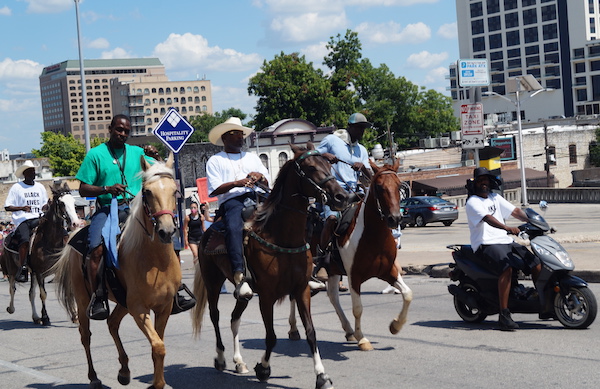
“I feel crushed under the weight of my grief,” she said. Ramos’ son was shot by an officer as he tried to drive away during an attempted arrest, after police already had shot him with a non-lethal ‘impact round.’ Ramos’ mother said there was no reason to escalate the situation by shooting him with such a round, and pointed out that he had no gun. The Travis County District Attorney’s Office is investigating the case, but hasn’t announced any charges.
“We want to pass a law that this won’t happen again to anybody. No one. No one.”
For Brenda Ramos, as for many protesters, #BlackLivesMatter isn’t just a hashtag, a movement, or a matter of politics and policy debate — it’s a personal matter. “I’m out here and marching because I’m a biracial woman and I love a Black man and I’m tired of worrying about him when he leaves the house,” said Michaela Spenrath.
She carried a sign calling on police to “protect and serve.” Spenrath said, “The master of our police force should be justice. It shouldn’t be racism, it shouldn’t be discrimination. It should be Lady Justice and protection of all American citizens equally.”





